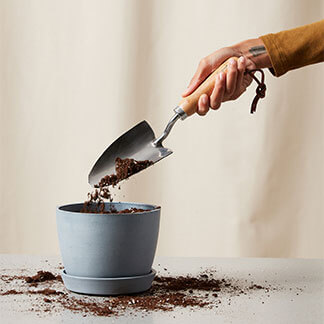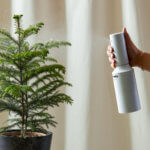Water Frequency
Both too much and too little water will damage palms and will lead to leaf yellowing, and browning.
Most palms prefer to be watered when 50% of their soil volume is dry. Always check the soil before watering to make sure it needs it. Water thoroughly and discard any excess water from the saucer. If you water too often it can lead to yellowing and eventual root rot.
Water Quality
Look out for a common problem called ‘tipping’ when the tips of the leaves dry out and turn brown. The most common cause is tap water, which contains salts, chlorine, fluoride, and other elements that may be harmful in excess. To prevent this, you can use distilled water or rainwater.
You can flush the soil a few times a year if you start to notice salt buildup in the form of a white crust-like cover on the top of the soil. Do this by removing that top later of soil and slowly but generously watering your Palm with about four times your pot’s volume of water. Allow water to completely drain from the pot and empty the saucer of any excess water before placing your Palm back in its place.
Over-Fertilization
Fertilizer replenishes nutrients in the potting soil, but too much fertilizer causes leaf tips to brown and can lead to plant health decline. Fertilize Palms only when they are actively growing in the spring and summer months. Dormant Palms do not need additional fertilizer. Use a fertilizer formulated for palm trees at the rate recommended on the package. Remember: more fertilizer is not necessarily better. Always fertilize on moist soil as doing so on dry soil can burn the roots.
Cold Injury
Palms require warm temperatures to thrive. While indoor plants are usually kept warm, cold damage can still occur. Place plants in areas away from window and door drafts where cold air can cause leaf tip browning. Avoid setting plants so they touch the windows in winter, as leaves touching the glass can freeze and brown. In summer, don’t place directly in the path of an air-conditioning vent.
Natural Browning
Palms replace their leaves throughout the growing season. As a palm tree leaf reaches the end of its natural life, it turns brown–beginning at the tip and continuing until the leaf completely browns and drops off. If only one or two leaves are browning and new foliage continues to grow in, the brown tips are natural and not a cause for concern.
Here’s how to properly trim your plant of any brown tips:
- Gather your supplies. You’ll need a pair of sharp scissors or pruning shears, some rubbing alcohol, and paper towel. (Alcohol wipes that come in a first-aid kit work great!)
- Wipe the blades of your sharp scissors or pruning shears with rubbing alcohol before you begin and between each snip. If you are just removing brown crispy leaves due to aging, lack of moisture, or sunburn spots; moisten the blades with water before cutting–this will help prevent healthy tissue damage.
- Cut leaves that are entirely brown or yellow at the base – near the stem or at the soil. Be sure not to tug the leaves, as this can damage healthy parts of the plant. If only part of the leaf is brown or yellow, remove only the affected area.
Important: Be careful not to remove more than 30% of the entire plant while pruning. You may need to prune in stages to avoid removing too many leaves at once.










